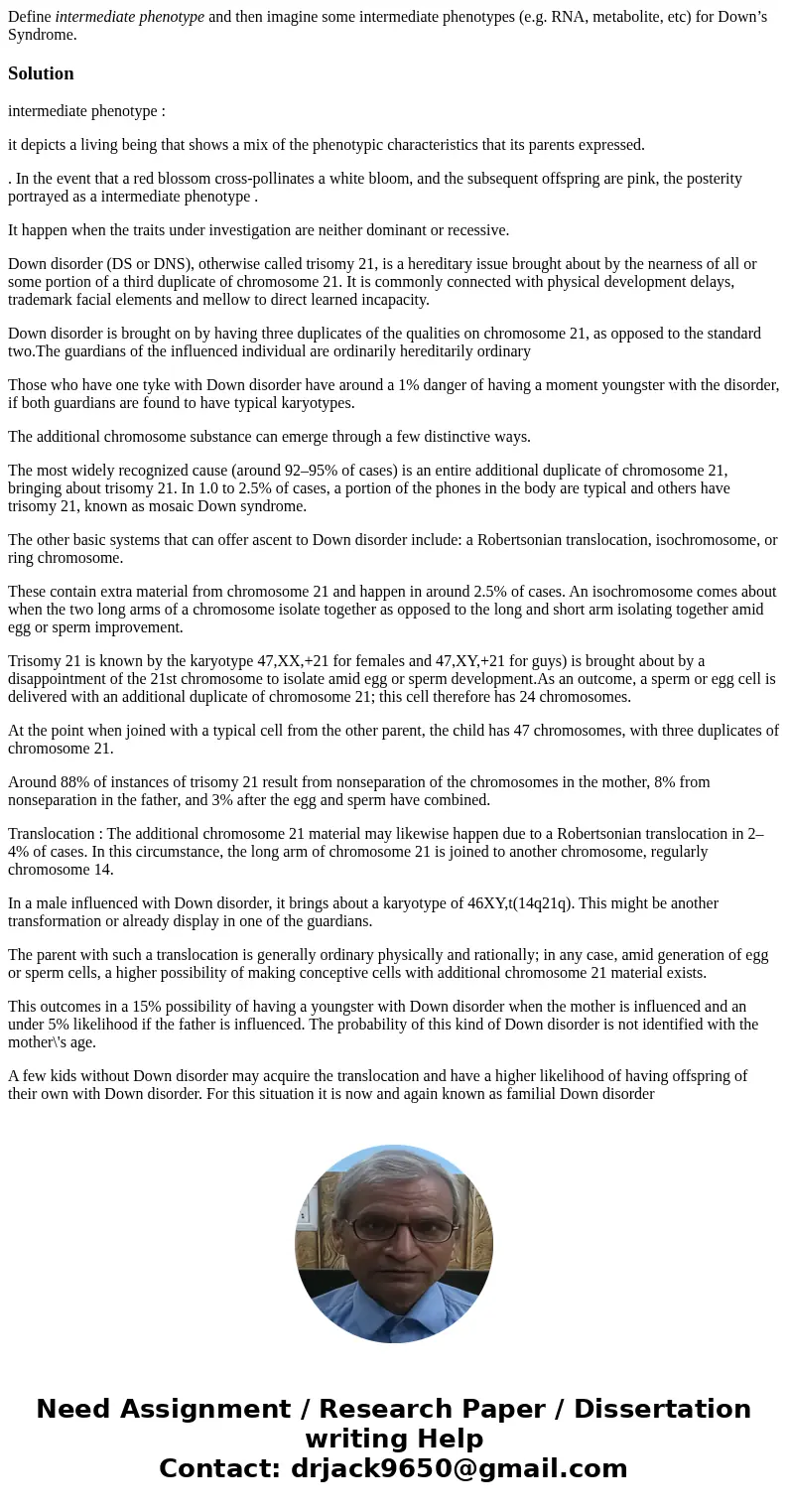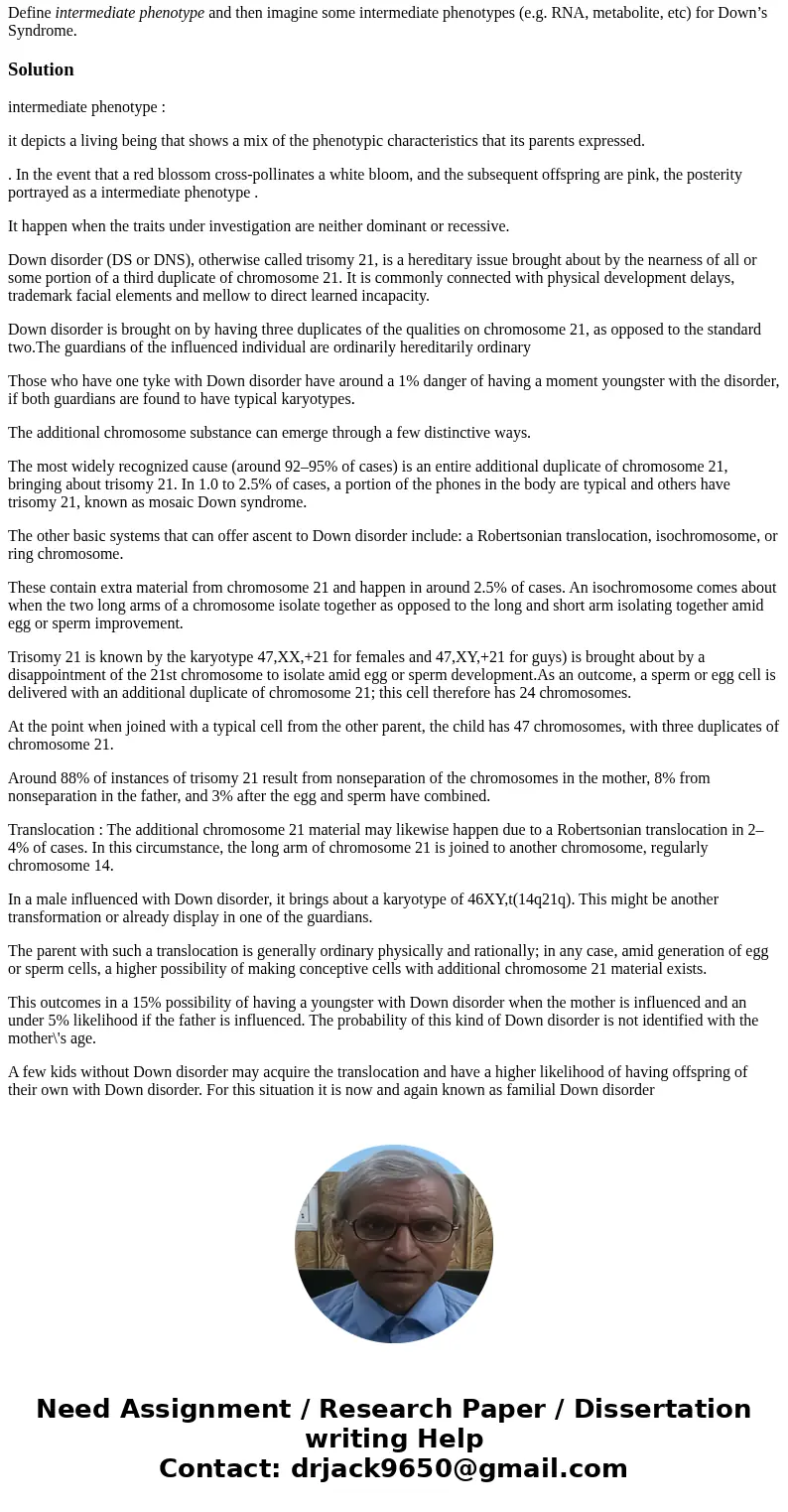Define intermediate phenotype and then imagine some intermed
Define intermediate phenotype and then imagine some intermediate phenotypes (e.g. RNA, metabolite, etc) for Down’s Syndrome.
Solution
intermediate phenotype :
it depicts a living being that shows a mix of the phenotypic characteristics that its parents expressed.
. In the event that a red blossom cross-pollinates a white bloom, and the subsequent offspring are pink, the posterity portrayed as a intermediate phenotype .
It happen when the traits under investigation are neither dominant or recessive.
Down disorder (DS or DNS), otherwise called trisomy 21, is a hereditary issue brought about by the nearness of all or some portion of a third duplicate of chromosome 21. It is commonly connected with physical development delays, trademark facial elements and mellow to direct learned incapacity.
Down disorder is brought on by having three duplicates of the qualities on chromosome 21, as opposed to the standard two.The guardians of the influenced individual are ordinarily hereditarily ordinary
Those who have one tyke with Down disorder have around a 1% danger of having a moment youngster with the disorder, if both guardians are found to have typical karyotypes.
The additional chromosome substance can emerge through a few distinctive ways.
The most widely recognized cause (around 92–95% of cases) is an entire additional duplicate of chromosome 21, bringing about trisomy 21. In 1.0 to 2.5% of cases, a portion of the phones in the body are typical and others have trisomy 21, known as mosaic Down syndrome.
The other basic systems that can offer ascent to Down disorder include: a Robertsonian translocation, isochromosome, or ring chromosome.
These contain extra material from chromosome 21 and happen in around 2.5% of cases. An isochromosome comes about when the two long arms of a chromosome isolate together as opposed to the long and short arm isolating together amid egg or sperm improvement.
Trisomy 21 is known by the karyotype 47,XX,+21 for females and 47,XY,+21 for guys) is brought about by a disappointment of the 21st chromosome to isolate amid egg or sperm development.As an outcome, a sperm or egg cell is delivered with an additional duplicate of chromosome 21; this cell therefore has 24 chromosomes.
At the point when joined with a typical cell from the other parent, the child has 47 chromosomes, with three duplicates of chromosome 21.
Around 88% of instances of trisomy 21 result from nonseparation of the chromosomes in the mother, 8% from nonseparation in the father, and 3% after the egg and sperm have combined.
Translocation : The additional chromosome 21 material may likewise happen due to a Robertsonian translocation in 2–4% of cases. In this circumstance, the long arm of chromosome 21 is joined to another chromosome, regularly chromosome 14.
In a male influenced with Down disorder, it brings about a karyotype of 46XY,t(14q21q). This might be another transformation or already display in one of the guardians.
The parent with such a translocation is generally ordinary physically and rationally; in any case, amid generation of egg or sperm cells, a higher possibility of making conceptive cells with additional chromosome 21 material exists.
This outcomes in a 15% possibility of having a youngster with Down disorder when the mother is influenced and an under 5% likelihood if the father is influenced. The probability of this kind of Down disorder is not identified with the mother\'s age.
A few kids without Down disorder may acquire the translocation and have a higher likelihood of having offspring of their own with Down disorder. For this situation it is now and again known as familial Down disorder


 Homework Sourse
Homework Sourse